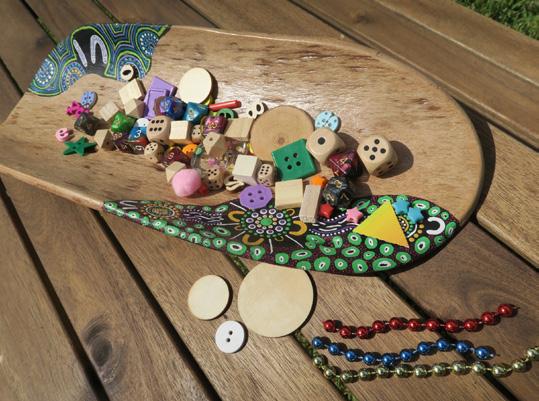
3 minute read
School Readiness with Loose Parts
‘School readiness’ can be a daunting phrase. How do you balance the pressure from families to prepare their children for school and academic success, with the best practice guidelines of the NQF around child-focused, play-based learning? The answer is easier than you may think… Loose Parts.
Loose parts are such a great resource and can be used with all ages. Younger children can explore larger loose parts made up of an assortment of everyday items so that they can become familiar with these items and transfer knowledge learnt through play into real world experiences. Older children can have smaller loose parts to challenge fine motor and help get those fingers and hands ready for writing at school, as well as using larger loose parts in outdoor environments to help build core control and muscle tone - important for sitting at desks for longer periods of time.
Not only do loose parts support physical development but they also can be made up of anything you choose to add, so for children who have specific school readiness goals you can add specific loose parts to support them. The more items you have in your loose parts collection, the more school readiness opportunities there are based on each child’s ideas and play. Two of the biggest pressures for school readiness are literacy and numeracy so I will focus on them and how you can support these through loose parts play.
Literacy
There are so many ways to add literacy to your loose parts kit to invite and encourage children to learn about letters and symbols. Not every child will feel comfortable holding a pencil and writing on paper as that is permanent and, if they make a mistake, it will be there forever. For those children, playing with letters in loose parts is a gentle way to build confidence without the permanency of writing on paper.
There are a lot of different letter shapes you can add, the more styles, fonts, upper and lower case letters, the more confident children will get at recognising letters as they are not always going to be in the one font in the real world.
Once you add letters you invite letter recognition, spelling, letter sounds discussions, and more. You can start to look at directional use of letters moving from left to right and top to bottom as you use them. You can also provide additional props such as name cards, alphabet books and similar to support children to focus on letters in their play.
You do not need to add letters to start looking at literacy school readiness, you can also add symbols such as logos, Indigenous symbols, braille, letters from other alphabets, numbers, punctuation etc. Letters and symbols follow the same rules because they represent meaning. You can also add items such as bread tags as they introduce text in meaningful ways (not to mention opportunities to explore recycling and sustainability).
Numeracy
There are so many different aspects of numeracy that it is impossible not to include items that support this in your loose parts play. Every item has size, shape, weight, measurements, is bigger or smaller than other items, is heavier or lighter than other items, not to mention the items can be counted.
If you want to add specific numeracy skills into your loose parts kit a great starting point is to get some dice. Not only do they encourage children to count out items in relation with the number on the die, but dice also support recognition of numbers through the dots and with repeated use children became able to recognise a number without counting the dots. You can also get dice with different numbers on them and different number of sides to help support this recognition.
You could also add different shapes, either cut them out yourself from felt or card, or get some cheap buttons of different shapes. You may also like to add the challenge of 3D shapes and start exploring their names if children are showing an interest. Another way to encourage children to focus on size differences is by having similar items in different sizes such as different lengths of ribbon, or different size wooden discs. These encourage children who like to find similar items to recognise their differences and discuss size.
Final thoughts…
• Loose parts should be about investigation, exploration, and open-ended play, children should not be made to use the items in a specific way, instead invited to do so by the items you offer and the role modelling you provide.

• When you are playing alongside the children with the loose parts you can assess their awareness of shapes, letters, numbers etc. through play by asking them to pass you items for your play.
• Remember to keep play child-focused and interact in meaningful ways, not just quizzing children but instead following their lead and understanding their thinking.
• When sharing the learning with families make the school readiness skills clear - don’t hide them behind learning outcome codes.
• School readiness can happen anywhere, anytime, and is about responsive teaching and scaffolding more than it is about structured experiences. The more fun an experience is, the more children will engage and retain information as it becomes meaningful to them.








